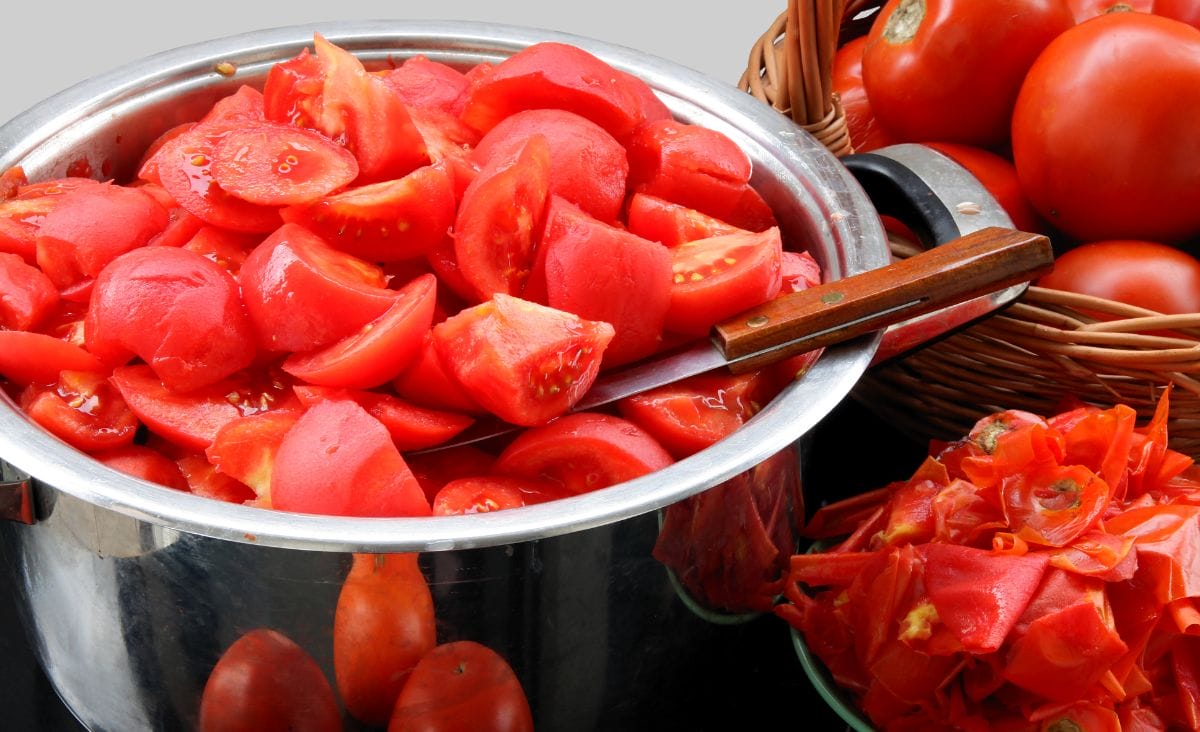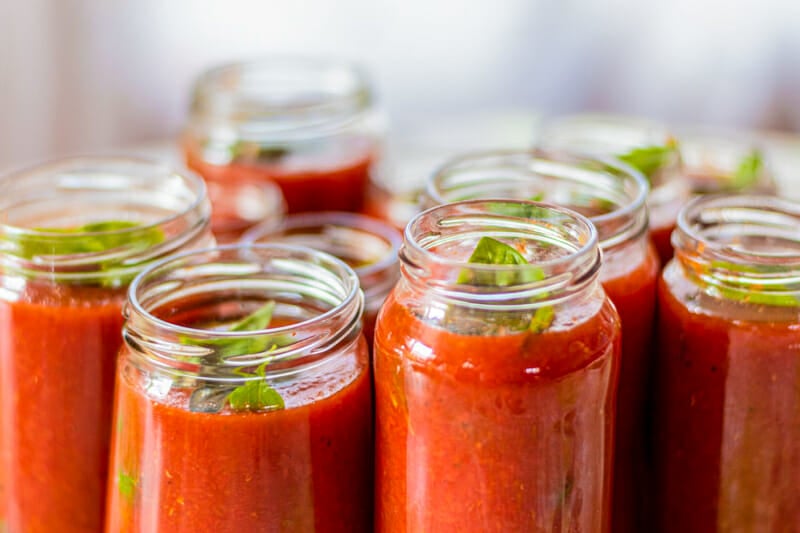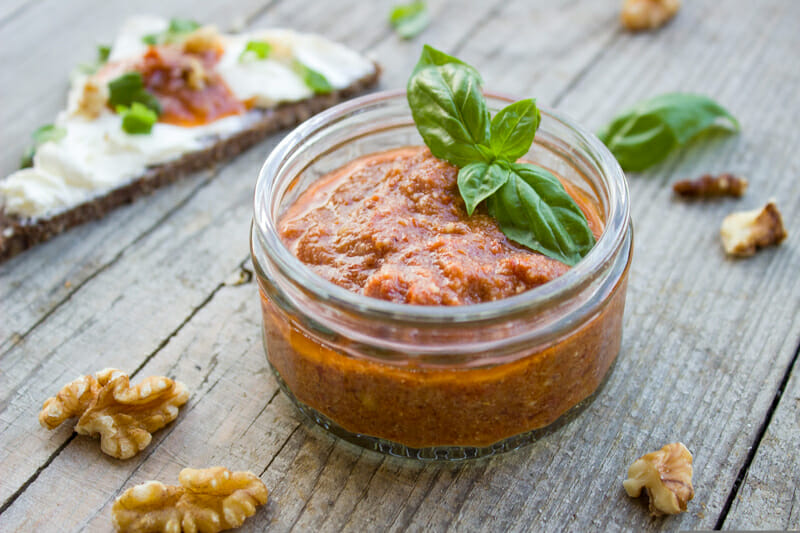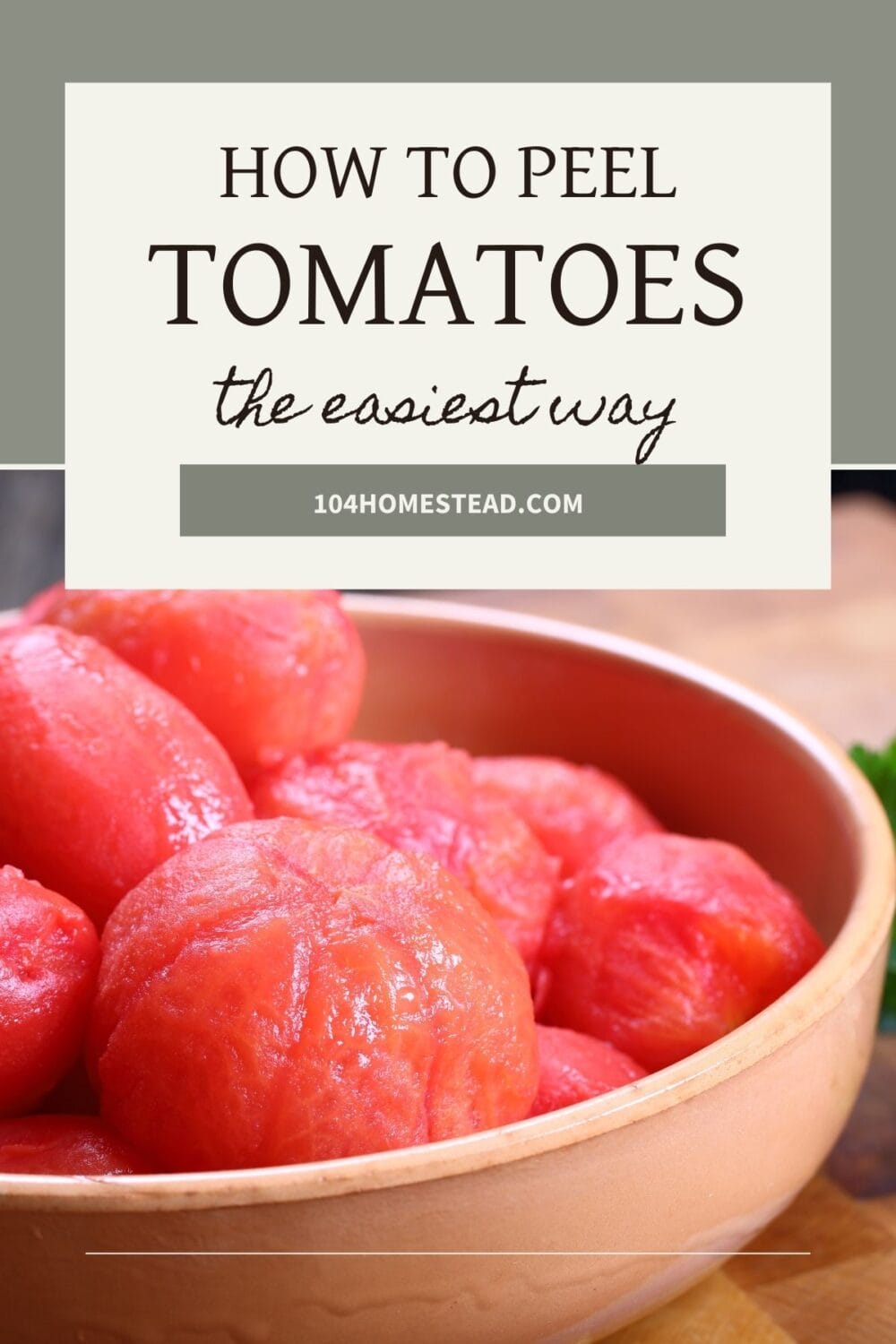How to Peel Tomatoes Without Boiling or Ice Bath
Learn how to peel tomatoes with bath-temperature water in less than a minute. All you need is a clean sink. This is a great tip for busy cooks.

Did you just harvest your tomatoes for the year? Did you have a fabulous crop of tomatoes? Canning homegrown tomatoes can be very rewarding, but it can also be very tedious and time-consuming. The hardest part, in my opinion, is peeling all those tomatoes. Do you know how many tomatoes are in fifteen pounds of tomatoes? It’s a lot. Enough to make your fingers pruney.
And don’t get me started on the old-fashioned method of boiling water and ice baths. It’s enough to drive someone away from tomato preservation and sauce-making. This is hands-down the easiest way to remove tomato skins. You can now look forward to tomato season without feeling overwhelmed.
An Easier and Faster Way to Peel Tomatoes
I’ve got a way to get through the peeling phase so much faster. This method is great for those of us in colder climates who only get a few tomatoes at a time. I usually collect a handful of them each day. They’d rot if I left them out until I had enough to process. That brings me to the first step of quick and easy peeling.
Pop them in the freezer.
I don’t wash my tomatoes before I freeze them. I just stick them in a storage bag. Sometimes, I remove the stems, but it really depends on how busy I am. They often go in the freezer in the same condition as when they came off the vine.
Tomatoes can last in the freezer for months. This works well if the harvest season is super busy for you. You can return and do your tomato preservation when things settle down. Other types of produce are not as forgiving.
Pop them into warm water.
Leave your tomatoes in the freezer until the absolute last minute. Since my tomatoes are kept in batches of 4 lbs, I only remove and peel one bag at a time. Prepare warm water in either the sink or a large mixing bowl. Plop your frozen tomatoes in and give them a swish. You want all sides of the tomato to have contact with the water. Be sure to work quickly because the longer the tomatoes sit, the harder it is for this trick.

Squeeze the fat end.
Find the end of the tomato that had the stem. Gently squeeze the tomato on the opposite end with a pulling motion, and the tomato will pop out, leaving the skin in your fingers. If a little skin remains on the opposite end, just pinch it to remove it, and it will come right off. Just pop your peeled tomatoes into a large bowl and put the skins into the compost.
Done!
This method works best with Romas since they fit nicely in the hands, but it will work on all kinds of tomatoes. You may have to squeeze or pinch the sides with large tomatoes, like beefsteaks, but the freeze method will still make it infinitely easier.
See the instructions in action:
Tip: Consider sun-drying your peeled tomatoes to intensify their flavor. After peeling, slice the tomatoes and arrange them on a clean, flat surface in direct sunlight. The natural dehydration process concentrates the sweetness and richness of the tomatoes, resulting in a more robust flavor profile for your culinary creations. Sun-dried tomatoes can be stored in olive oil for added depth or used directly in various dishes, adding a gourmet touch to your homemade recipes.

Frequently Asked Questions
Ideas for Your Peeled Tomatoes
So you’ve got them all peeled and ready to go. Now it’s time to enjoy making a myriad of soups, tomato sauces, and other delicious tomato recipes.

Here are a handful of recipes for you to try:
My homemade spaghetti sauce recipe combines rich, aromatic tomatoes with a blend of savory herbs and spices, creating a flavorful and versatile sauce perfect for any pasta dish. Simmered to perfection, this sauce captures the essence of Italian cuisine, making it a delicious and comforting addition to your favorite pasta or a base for other culinary creations. With a touch of sweetness and depth of flavor, it’s a delightful homemade alternative to store-bought sauces.
Love and Lemons’ fresh tomato sauce recipe is a celebration of simplicity and vibrant flavors. Bursting with the goodness of ripe tomatoes, garlic, and basil, this sauce comes together effortlessly, letting the natural sweetness of the tomatoes shine through. It’s a light and versatile sauce that elevates any pasta dish, providing a taste of summer with every spoonful.
Spend With Pennies’ fresh tomato soup recipe is a comforting and wholesome take on a classic favorite. Using ripe tomatoes, aromatic herbs, and a touch of cream, this soup is a delightful blend of richness and freshness. With its velvety texture and homemade goodness, it’s a perfect bowl of warmth for any season.
The Mediterranean Dish’s easy tomato gazpacho recipe is a refreshing and vibrant take on the classic Spanish cold soup. Bursting with the flavors of ripe tomatoes, cucumbers, and bell peppers, this gazpacho is a symphony of Mediterranean freshness. Blended to perfection with a hint of garlic and olive oil, it’s a cool and invigorating dish that captures the essence of summer in every spoonful.
Save Your Peels and Seeds
And don’t go chucking the peels in the garbage. Either compost them into nutrient-rich soil for your garden, give them to your chickens as a delightful and healthy snack, or check out my friend Angi’s site to find out how to get the most from your tomato harvest (including the peels).
And while you’re at it, make sure you save those tomato seeds!
If you’ve found value in this blog post and enjoyed reading it, why not share it with your Pinterest community? Pin the image below and spread the love!

Peeling tomatoes can be a tedious and time-consuming task, but with this easy and fast method of using bath-temperature water, the process becomes a breeze. By freezing the tomatoes first and then quickly submerging them in warm water, you can effortlessly remove the skins and enjoy a variety of delicious tomato recipes. Say goodbye to the boiling and ice bath method, and say hello to stress-free tomato preservation!
Have you ever tried peeling tomatoes using the freezing and warm water method? I’d love to hear about your experiences and any other tips or tricks you have for peeling tomatoes quickly and easily. Share your thoughts in the comments below.
